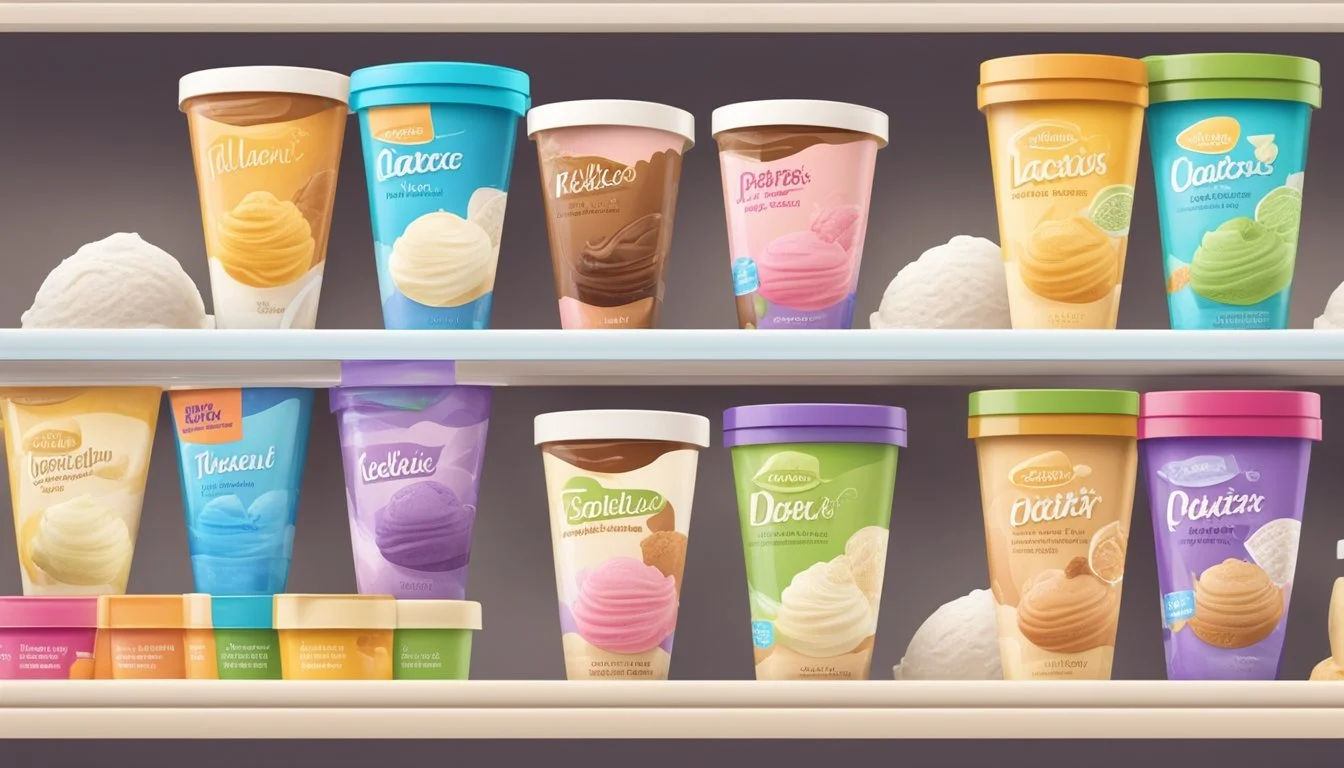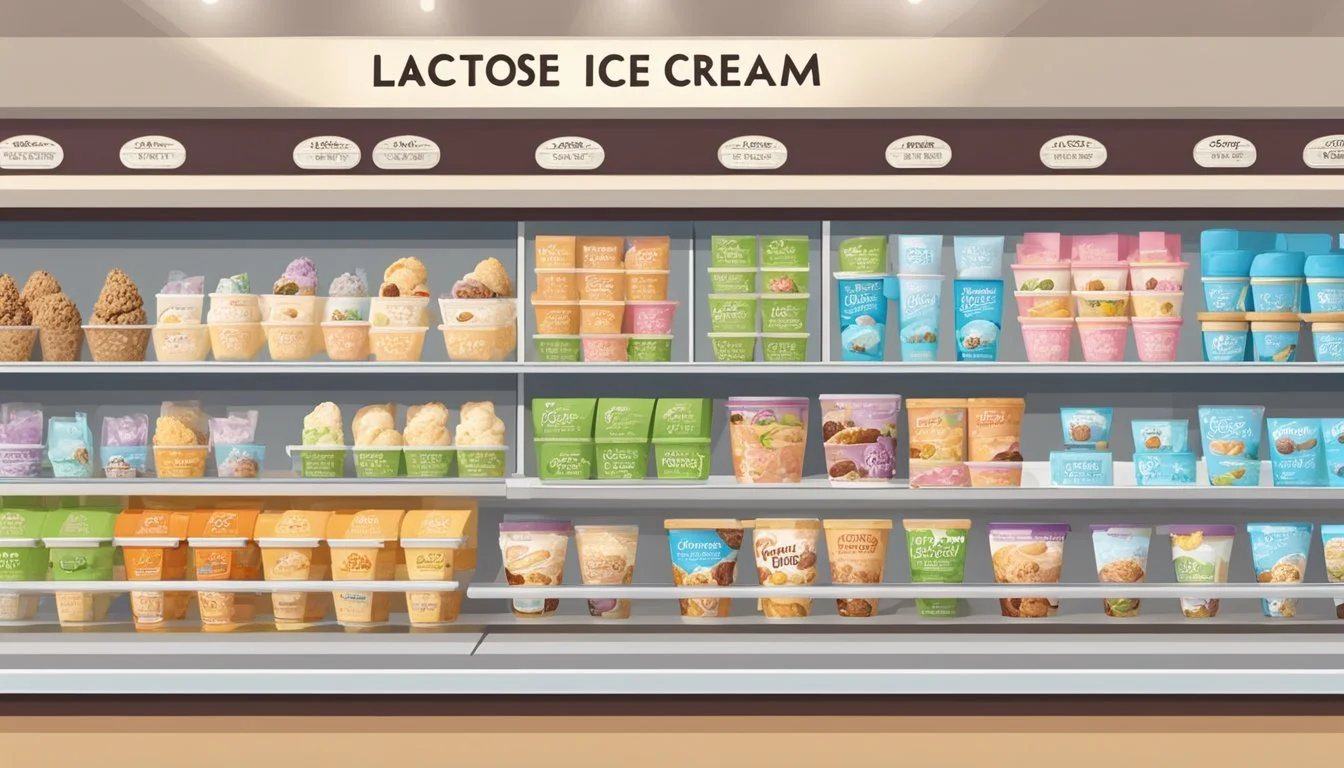What Are Some Lactose-Free Ice Cream Options?
Your Guide to Dairy-Free Delights
Lactose-free ice cream offers a delightful solution for ice cream enthusiasts who are lactose intolerant or simply looking to avoid dairy. Thanks to advancements in food science and the rise of dietary awareness, the variety of lactose-free ice creams has expanded significantly. This variety includes options that range from those that are dairy-derived but lactose-free, to completely dairy-free alternatives made from various plant-based milks like oat, almond, and coconut.
For individuals who are lactose intolerant, lactose-free dairy ice cream is a popular option where lactase enzyme is added to traditional dairy milk to break down lactose, making it digestible. On the other hand, the market now also brims with dairy-free options, which sidestep animal products altogether, catering not only to those who shun lactose but also to vegans and those with dairy allergies. These ice creams often deploy the creamy textures of plant-based milks and can be found in an array of flavors to satisfy diverse palates.
Every year, new brands and varieties enter the scene, each offering its take on lactose-free ice cream. Whether one opts for a pint of dairy-derived, lactose-free chocolate ice cream or ventures into the realm of oat milk-based vanilla, these innovations ensure that the experience of enjoying a cold, creamy treat remains inclusive and accessible to all.
Understanding Lactose Intolerance
In exploring lactose-free ice cream options, it's essential to first grasp the concept of lactose intolerance and its nutritional implications.
What Is Lactose Intolerance?
Lactose intolerance occurs when an individual's digestive system cannot fully digest lactose, a sugar found in milk and dairy products. People with this condition lack sufficient levels of the lactase enzyme in their small intestine, leading to digestive issues when they consume lactose-containing foods.
Lactase Enzyme and Digestion
The lactase enzyme is critical for breaking down lactose into glucose and galactose, which can then be absorbed into the bloodstream. Without adequate lactase, lactose remains in the digestive system, causing symptoms such as bloating, gas, and abdominal pain. Consequently, lactose intolerant individuals often seek out lactose-free alternatives to standard dairy products.
Types of Lactose-Free Ice Cream
Lactose-free ice cream provides delicious alternatives for those with lactose intolerance or dietary preferences. Available in a range of flavors and bases, these ice creams ensure that everyone can enjoy a frozen treat without discomfort.
Sorbet and Sherbet
Sorbet is a fruit-based frozen dessert, often vibrant in taste and dairy-free, focusing on the natural sweetness and tartness of its fruit ingredients. Sherbet, slightly creamier due to a minimal dairy content, usually still qualifies as lactose-free, but those with sensitivities should check labels carefully.
Coconut Milk-Based Ice Cream
Ice cream made with coconut milk is a creamy, tropical-flavored option that is naturally lactose-free. It captures the essence of coconut and can carry additional flavors well, offering a richness similar to traditional ice cream.
Almond Milk-Based Ice Cream
Almond milk provides a lighter base for lactose-free ice cream. The subtle nutty flavor is versatile, making it ideal for a range of flavored ice creams from classic vanilla to intricate combinations.
Cashew Milk-Based Ice Cream
Cashew milk-based options offer a rich and creamy texture akin to dairy. Cashew milk delivers a smooth finish ideal for decadent flavors like chocolate and butter pecan.
Oat Milk-Based Ice Cream
Oat milk is a newer entrant to the dairy-free ice cream market. Its mild flavor and creamy consistency are excellent for those seeking a lactose-free product that closely resembles the taste and texture of dairy ice cream.
Soy Milk-Based Ice Cream
Soy milk-based ice creams are well-established in the non-dairy market. They are a dependable option for a variety of flavors, catering to both those who prefer classic tastes and those looking for a vegan ice cream experience.
Popular Dairy-Free Brands
For those seeking alternatives to traditional dairy products, various brands have established a strong presence in the lactose-free ice cream market. These brands offer a wide range of flavors and base ingredients, catering to different preferences and dietary needs.
So Delicious
So Delicious uses a variety of non-dairy bases such as coconut milk, almond milk, cashew milk, oat milk, and soy milk for its ice cream products. They are known for providing a rich taste experience similar to traditional ice cream. Lactose-free vanilla is among the flavors they offer, giving a classic option for consumers.
Van Leeuwen
Van Leeuwen started as an artisan ice cream truck and now offers a line of dairy-free ice creams made from cashew milk, coconut cream, and oat milk as base ingredients. Their dairy-free flavors have become highly popular, with the brand receiving accolades for its creamy texture.
Oatly
Oatly, originally known for its oat milk, has expanded into the ice cream sector with a variety of flavors made from oats. Oatly's dairy-free ice cream line puts an emphasis on sustainability and is known for its distinct oat base, which offers a unique flavor profile and creamy consistency.
Coconut Bliss
Coconut Bliss focuses on creating dairy-free frozen desserts from organic coconut milk. One of their standout features is the use of agave syrup as a sweetener, which is considered a healthier alternative to traditional sugar. Their offerings include flavors like chocolate chip cookie and salted caramel, which have gathered a significant following.
Nadamoo
Nadamoo provides a selection of dairy-free ice creams made primarily from coconut milk. The brand prides itself on using organic, non-GMO ingredients. Their lactose-free vanilla and a variety of creative flavors showcase the brand's commitment to catering to the dairy-free market while maintaining a delicious taste.
Homemade Ice Cream Alternatives
Crafting ice cream at home allows for customization and ensures that the final product is entirely lactose-free. Utilizing fruits, avocados, and nut butters, individuals can create a diverse range of flavors and textures.
Using Fruit Bases
Fruit-based ice creams are a refreshing and straightforward option for lactose-free homemade ice cream. By pureeing fruits such as bananas, mangoes, or peaches, one can achieve a creamy consistency without the need for dairy. For added creaminess, low-fat coconut milk or other non-dairy milks can be incorporated. Fruits serve as natural sweeteners, reducing the need for added sugars.
Examples of fruit bases:
Bananas: When frozen and blended, they create a smooth and creamy texture.
Berries: A tangy option that is rich in antioxidants and vibrant in color.
Avocado-Based Options
Avocado has become a popular base for dairy-free ice cream due to its creamy texture and nutritional profile. To create Avocado Ice Cream, one can blend ripe avocados with water and a choice of sweeteners until smooth. The addition of vanilla extract enhances the creaminess and flavor. Avocado-based ice creams can be enjoyed with various flavor additions, such as chocolate or mint.
Key ingredients for Avocado Ice Cream:
Avocado: The main ingredient providing a rich, creamy texture.
Sweetener: Options include honey, maple syrup, or sugar alternatives.
Nut Butter Infusions
Integrating nut butters into dairy-free ice cream creates a rich and indulgent treat. Almond, peanut, or cashew butter can be mixed into the base before freezing. This not only enriches the flavor but also contributes a smooth consistency that mimics traditional dairy ice creams.
Suggestions for nut butter ice creams:
Almond Butter: Mild and versatile, pairing well with chocolate or vanilla.
Cashew Butter: Naturally sweet, it can be used to create decadent frozen desserts.
When choosing to make homemade ice cream, individuals can explore a wide array of flavors and textures, all while adhering to a lactose-free diet. The options are customizable, ensuring there's a dessert to satisfy every palate.
Health Considerations
When selecting lactose-free ice cream, various health aspects come into play. Consumers should carefully consider fat content, presence of additives, sugar and calorie count, as well as the availability of non-GMO and organic options, to meet their personal dietary goals and preferences.
Examining Fat Content and Additives
Lactose-free ice creams vary in their fat content. Some mimic traditional dairy ice cream, integrating lactase enzyme into dairy milk to remove lactose while retaining a creamy texture. However, these can still be high in saturated fat. On the other hand, plant-based alternatives often use oils, which can alter the type of fat present. Consumers are encouraged to read labels for specific fat content to adhere to their dietary requirements.
In terms of additives, it's common for lactose-free ice cream to contain stabilizers or emulsifiers to achieve the desired consistency. These additives are safe for most, but for individuals with sensitivities, it's imperative to be vigilant about ingredient lists.
Sugar and Calorie Content
Calories and sugar in lactose-free options can be as significant as in ordinary ice cream. Here’s a general comparison:
Type Average Calories per 1/2 cup Average Sugar Traditional Dairy Ice Cream 130-230 14-24g Lactose-Free Dairy Ice Cream 90-200 10-20g
Some lactose-free ice creams may use sugar substitutes or sugar alcohols, which can reduce calorie count but may affect blood sugar or cause digestive issues for some individuals.
Non-GMO and Organic Options
Non-GMO and organic products appeal to health-conscious consumers and those desiring natural ingredients. Non-GMO implies that the ingredients in the lactose-free ice cream come from sources that have not been genetically modified. Meanwhile, organic lactose-free ice creams eschew synthetic pesticides and fertilizers, offering a cleaner label. These options may sometimes offer nutritional benefits, like higher levels of certain antioxidants.
Finding Lactose-Free Ice Cream
Consumers seeking lactose-free ice cream have a variety of options to consider. Retailers are increasingly stocking lactose-free alternatives, and many brands now offer a wide range of flavors to accommodate dietary restrictions.
Supermarkets and Store Selection
Supermarkets such as Target have dedicated sections for lactose-free products, including ice cream options. Brands like Lactaid specialize in lactose-free dairy products and provide a selection of ice cream that's tailored for those with lactose intolerance. Consumers can typically find these options in the frozen dessert aisle alongside traditional ice cream. It's important to read labels to ensure the product meets dietary requirements.
Ice Cream Shops and Restaurants
Ice cream shops may offer lactose-free options, although the availability can vary widely from one location to another. Patrons should inquire with staff about their lactose-free offerings. Restaurants, when providing dessert menus, might list lactose-free ice cream as an alternative to their regular ice creams. Some may source from store-bought brands, while others might have in-house lactose-free versions.
Online Purchases and Deliveries
Providers such as Daily Harvest offer direct delivery services for lactose-free ice cream. Customers can place orders online from their selection of dairy-free frozen desserts, which include various flavors and are often made with natural ingredients. These online purchases offer a convenient way to access a broader variety of lactose-free ice creams that may not be available locally.
Consumer Guidance
When selecting a lactose-free ice cream, it's essential to understand product labeling, be aware of dairy alternatives, and consider product reviews and recommendations. These factors ensure that consumers make informed choices that align with their dietary needs and preferences.
Reading Product Labels
Consumers should scrutinize product labels for terms like "lactose-free" and "dairy-free." Lactose-free options may still contain dairy milk, but with the lactose sugar broken down, usually by the addition of the enzyme lactase. Dairy-free alternatives, on the other hand, are made without any dairy ingredients and are suitable for those avoiding all dairy products.
Look for Certified Labels: Seek out ice creams labeled as "lactose-free" or "non-dairy" to ensure they meet specific standards.
Check Ingredient Lists: If a product contains milk with the lactose removed, it should list a synthetic lactase enzyme as an ingredient.
Allergen Information: Lactose-intolerant individuals should also watch for other potential allergens like nuts or soy, which are common in non-dairy alternatives.
Understanding Dairy Alternatives
For those seeking non-dairy options, there are a variety of base ingredients that can substitute for dairy milk. These include almond, coconut, soy, oat, and rice, each offering a different flavor and nutritional profile.
Almond Milk: Low in calories and with a nutty flavor, it's a common non-dairy base for ice cream.
Coconut Milk: Rich and creamy, it's frequently used in lactose-free options and provides a distinct coconut taste.
Table 1: Common Dairy Alternatives in Lactose-Free Ice Cream
Alternative Base Characteristics Almond Milk Nutty flavor, lower in calories Coconut Milk Creamy texture, coconut flavor
Product Reviews and Recommendations
Prior to purchase, consumers should consider product reviews and expert recommendations. Products that substitute dairy with almond or coconut often feature in these reviews, and can provide insights into taste, texture, and overall quality.
Read Professional Reviews: Look for reviews from reputable sources that conduct taste tests, like Consumer Reports.
Customer Feedback: Check customer reviews for popular brands that offer lactose-free variants such as Coconut Bliss, which is known for its dairy-free and gluten-free options.
Table 2: Lactose-Free Options Mentioned in Reviews
Brand Review Highlights Coconut Bliss Organic, dairy-free, gluten-free, offers flavors like salted caramel and chocolate peanut butter Dairy Queen Their soft serve is low in milkfat but is not lactose-free
By carefully reading labels, understanding the variety of dairy alternatives, and assessing reviews and recommendations, consumers can find lactose-free ice creams that satisfy both their dietary needs and their taste preferences.
Creative Serving Ideas
Lactose-free ice cream offers a versatile canvas for a plethora of creative serving ideas. Whether interested in enhancing flavors or adding nutritional value, these suggestions cover various ways to elevate the simple scoop.
Pairing with Fruits and Nuts
To complement the smooth texture of lactose-free ice cream, one can introduce the natural sweetness and crunch of fruits and nuts. A classic combination could be a scoop of vanilla flavor ice cream topped with fresh strawberries and a sprinkling of chopped almonds.
Coco Flavor: Pair with banana slices and a generous handful of walnuts for a tropical twist.
Fruits: They not only add a fresh burst of flavor but also introduce more fiber and vitamins to the dessert.
Innovative Dessert Recipes
Lactose-free ice cream can serve as the cornerstone for innovative desserts. The ice cream can be mixed into a gluten-free ice cream cake, layered with fruits like peaches or cherries, or used as a filling for dairy-free crepes with a sprinkle of chocolate shavings for those who love the coco flavor.
Affogato: Pour a shot of hot espresso over a scoop of vanilla flavor lactose-free ice cream for an elegant and simple dessert.
Ice Cream Sandwiches: Nestle lactose-free ice cream between two dairy-free cookies for a delightful hand-held treat.
Healthy Toppings and Mix-Ins
There's room for health-conscious toppings that add texture and nutrient value to lactose-free ice cream without compromising taste.
Nuts: They offer a satisfying crunch along with healthy fats. Consider pistachios, pecans, or hazelnuts for a rich addition.
Seeds and Grains: Chia seeds, flaxseeds, or even granola can provide a pleasant texture contrast to the creamy ice cream.
Lactose-Free Ice Cream Innovations
The lactose-free ice cream market has evolved with significant innovations that expand consumer choices. These developments include the emergence of new market tendencies and advancements in food science that enhance flavor and texture.
New Market Trends
The most salient trend is the rise of plant-based alternatives, such as those utilizing pea protein, which cater to both lactose-intolerant consumers and the growing vegan community. Brands have capitalized on these trends, offering an assortment of flavors that prioritize simple, clean ingredients.
Coconut Bliss: Their products exemplify lactose-free options made from organic, non-dairy ingredients.
Breyers: This brand has introduced a lactose-free chocolate ice cream, reflecting a greater shift towards accommodating dietary restrictions.
Technological Advancements in Food Science
Innovations in food science have greatly enhanced the quality of lactose-free ice cream. Introduction of synthetic lactase enzymes into dairy milk mirrors traditional ice cream's taste while removing lactose.
Lactase Enzyme Technology: Enables the creation of lactose-free dairy ice creams without altering the classic creamy texture.
Perfect Day's Fermentation Process: This process creates animal-free dairy protein that retains the sensory profile of traditional dairy, exemplifying the forefront of dairy innovation.
These advancements showcase the industry's commitment to inclusivity and sustainability, leading to a rich variety of lactose-free ice cream options.
Conclusion
For those seeking the creamy satisfaction of ice cream without discomfort of lactose, the array of lactose-free options is impressive. Several brands specialize in creating non-dairy ice cream that maintains the traditional flavors and textures ice cream lovers crave. Coconut Bliss and Luna & Larry's have established themselves with a variety of flavors, from Chocolate Chip Cookie to Salted Caramel and Cold Brew Coffee.
Lactose-free dairy ice creams, created by the addition of lactase enzyme, allow for the enjoyment of dairy flavors without the lactose. This process ensures that people with lactose intolerance can still enjoy the taste of traditional dairy ice cream without any discomfort.
The market has also seen an increase in vegan and gluten-free varieties, expanding the offerings to cater to additional dietary restrictions and preferences.
The following table summarizes some notable lactose-free ice cream brands and their respective specialties:
Brand Dairy Free Vegan Gluten Free Notable Flavors Coconut Bliss ✓ ✓ ✓ Chocolate Peanut Butter, Naked Coconut Luna & Larry's ✓ ✓ ✓ Cold Brew Coffee Häagen-Dazs Non-Dairy Frozen Dessert
It is evident that consumers with lactose intolerance have a diverse selection of lactose-free ice creams at their disposal. They can confidently indulge in these alternatives without sacrificing taste or variety. The continuous innovation in the industry promises even more exciting developments for the lactose intolerant community.






